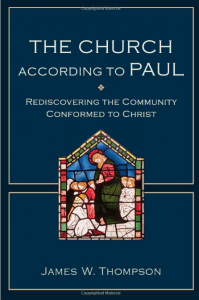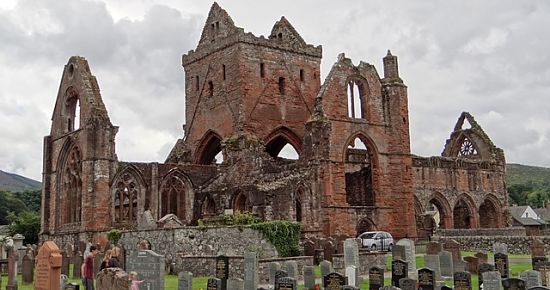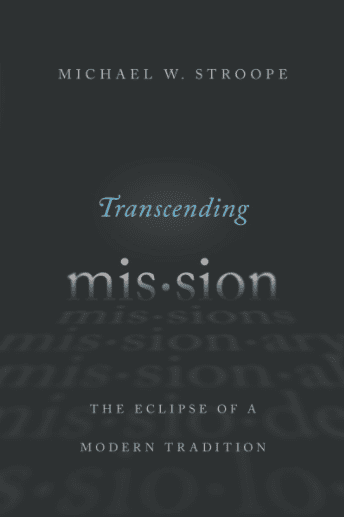 The church has fallen on hard times. Some have checked out, some have fought back. Both are responding to the hard times. James Thompson, in his well-researched book The Church according to Paul: Rediscovering the Community Conformed to Christ, opens with this story, and notice that last sentence, which will lead to our own story:
The church has fallen on hard times. Some have checked out, some have fought back. Both are responding to the hard times. James Thompson, in his well-researched book The Church according to Paul: Rediscovering the Community Conformed to Christ, opens with this story, and notice that last sentence, which will lead to our own story:
Shortly after the fall of the Berlin Wall, my wife and I visited a village church East Germany. Like the churches throughout other towns and villages of Germany, it stood at the center of town, with a spire that was visible from a distance. We entered a beautiful building that seated at least three hundred, but only twelve were in attendance on this Sunday morning—including the preacher, the organist, and us. If this village church was like others throughout Europe, it once would have been the center of community life, and the seats would have been filled. Now, however, it appeared to be a relic of the past.
A few years back Kris and I were in Venice on Pentecost Sunday, so we went to a historic Palladio-designed church. The doors were open, we walked in… and like the little hands game children play, we asked, “Where are all the people?” There were about twenty of us, most being members of the family of the child being baptized. Without that family there would have been fewer that ten. A “relic of the past,” no matter how magnificent the architecture. It was Pentecost Sunday at that!
So churches are reinventing themselves. Thompson thinks the declining churches and the growing churches could be equal in their faithfulness and that he is not offering a new reinvention of the church. Yes, he’s right: of the lines in the Creed the least resonant today may be “We believe in one holy catholic and apostolic church.” Some think the church has abandoned Jesus (or Jesus the church), others know the stories about the church that are not good stories, some that we can follow Jesus without the church, and yet others know that individualism in Protestant soteriology deconstructs the church (eventually).
What are the models of reinventing the church? Thompson gives these, and I ask What models of church are you seeing out there?
1. The church as political action committee. Liberal mainliners and conservative evangelicals both have found themselves in this box.
2. The church as corporation. Church growth principles focused on the homogenous unit. The aim here is growth.
3. The church as theater. Megachurches tend to congregate here: the focus is Sunday morning as a performance.
4. The church as association. Common interests gather here.
5. The missional church. He traces this to Lesslie Newbigin, to the mission of God, to the reign of God, and to the church of God. A theme is the church as alternative. He questions “sentness” as adequate or comprehensive enough. Thompson questions the missional church movement with this:
One is left with uncertainty about what is meant either by the missio Dei or by the kingdom. Should the missio Dei be understood primarily as God’s work in redemption, and thus the church is the primary way that God works in the world? Or should the missio Dei be understood as God’s work in all creation? The latter view marginalizes the church and envisions God at work outside the religious sphere. The task of the church, according to this understanding, is to discover what God is doing and then seek to participate in it. … Jesus did not invite his listeners to discover what God was already doing, but announced that the long-awaited kingdom was present in his ministry. While others healed and did acts of compassion, only Jesus inaugurated the kingdom. Thus one is left to wonder what the missional church advocates mean by their references to the kingdom. … If the church’s role is to discover what God is doing and then join in that, the kingdom of God could function without the church.
6. The emerging church.
Thompson, looking over some of these recent proposals, not least the missional and emerging church theories, and says this:
Attempts to reimagine the church have focused on strategies and often assume an ecclesiology without offering a critical analysis of the identity of the church. A special irony can be seen in the near absence from the discussion of Paul, the one who shaped communities more than anyone else we know. Paul offers the first written reflection on the nature of the church. Neither the attractional models of the church growth movement nor the missional or emerging church models incorporate Pauline theology at a substantive level into their understanding of the church.
Because we know more about Paul’s churches than we know about any other community in the New Testament, the apostle is the indispensable guide for anyone who looks for scriptural resources for reimagining the church.
Paul’s task was to define the community of believers in ways that did not conform to ancient concepts of community. When he converted people from different social classes and ethnic groups, he formed a community that was unparalleled in the ancient world. Thus his task was to build lasting communities, and his letters are attempts at ecclesial self-definition that challenged the common views of community.











